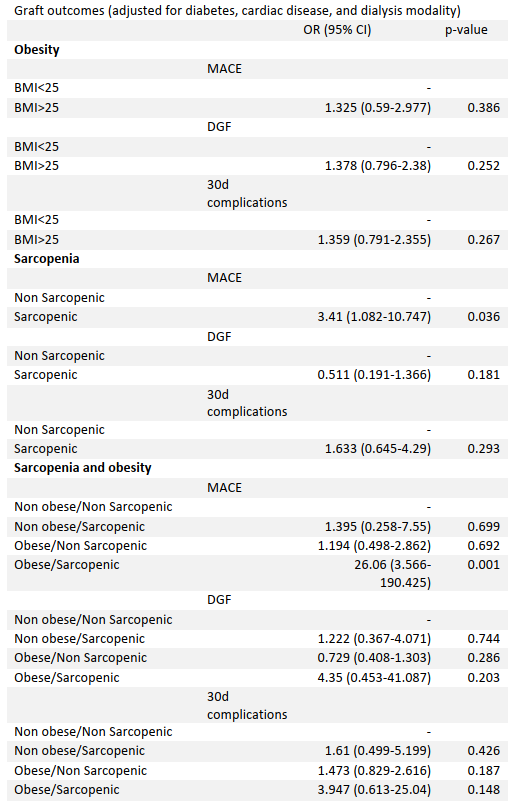Sarcopenia and Obesity in Renal Transplant Recipients – Effects on Graft and Patient Outcomes
C. Seet, M. R. Akhtar, L. Clementoni, M. Saoud, R. Shah, I. H. Mohamed, M. A. Khurram
The Royal London Hospital, London, United Kingdom
Meeting: 2022 American Transplant Congress
Abstract number: 219
Keywords: Kidney transplantation, Obesity
Topic: Clinical Science » Kidney » 35 - Kidney: Cardiovascular and Metabolic Complications
Session Information
Session Name: Kidney: Cardiovascular and Metabolic Complications II
Session Type: Rapid Fire Oral Abstract
Date: Monday, June 6, 2022
Session Time: 3:30pm-5:00pm
 Presentation Time: 4:00pm-4:10pm
Presentation Time: 4:00pm-4:10pm
Location: Hynes Veterans Auditorium
*Purpose: Body composition is associated with prognosis in a range of clinical settings, and patients with renal failure usually have significant comorbidities and are high risk for short and long-term morbidity and mortality. We aimed to assess the effect of sarcopenia and obesity on kidney transplantation outcomes.
*Methods: We performed a retrospective analysis of patients with kidney transplants between 2012-2016 with a CT scan within 3 years of transplantation. Skeletal muscle index (SMI, skeletal muscle area/height2) at the L3 vertebrae were used to evaluate sarcopenia. Patients were divided into four groups: sarcopenic obese, sarcopenic non-obese, non-sarcopenic non-obese, and non-sarcopenic obese, with 5 years follow up. BMI>25 was considered obese sarcopenia was defined as SMI<40.31cm2/m2 in males and >30.88cm2/m2 in females. Obesity and sarcopenia were also assessed individually. Univariate and multivariate analysis were performed to compare outcomes.
*Results: 174 patients were included in this study. 3 month graft function was significantly lower in obese patients (eGFR 39 vs 46ml/min, p=0.04) but not at other timepoints (1 month, 1, 3, and 5years). Sarcopenia alone was associated with lower eGFR at 1 month (33 vs 44ml/min, p=0.049), but there was no long-term difference. Sarcopenic obese patients had lower eGFR at 1 month, 3 months, 1 year and 3 years (p=0.004, 0.022, 0.009, 0.048). They also had poorer graft survival (p=0.029), although patient survival remained similar (p=0.60). In multivariate analysis adjusted for diabetes, cardiac disease, and pre-transplant dialysis modality, sarcopenic and sarcopenic obese patients had increased rates of major adverse cardiac events (OR 3.41, p=0.036 and OR 26.06, <0.001) but these effects were not seen by simple obesity assessment. There was no difference in DGF or post-operative complications across all groups.
*Conclusions: Sarcopenic obesity is associated with increased morbidity in kidney transplantation, and sarcopenic obese patients have poorer outcomes compared to patients with sarcopenia or obesity alone.
To cite this abstract in AMA style:
Seet C, Akhtar MR, Clementoni L, Saoud M, Shah R, Mohamed IH, Khurram MA. Sarcopenia and Obesity in Renal Transplant Recipients – Effects on Graft and Patient Outcomes [abstract]. Am J Transplant. 2022; 22 (suppl 3). https://atcmeetingabstracts.com/abstract/sarcopenia-and-obesity-in-renal-transplant-recipients-effects-on-graft-and-patient-outcomes/. Accessed January 3, 2026.« Back to 2022 American Transplant Congress

